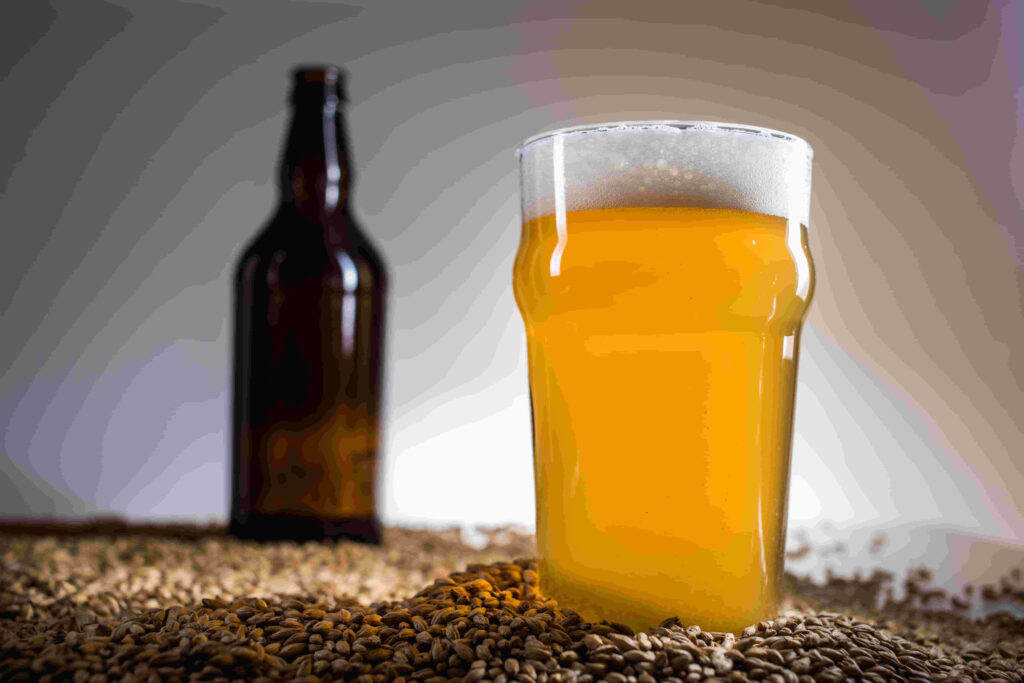Witbier, the spicy Belgian wheat beer
Belgian wheat beer, also known as Witbier or “bière blanche”, stands out as a remarkably refreshing beer style. Exhibiting a pale hue and often a subtle haze, this style offers a canvas for an array of ingredients, traditionally including unmalted wheat (or other grains, such as oats), spices such as orange peel and coriander seeds, and carefully selected yeast for Witbier that imparts signature fruity and spicy notes.
Characterized by a top-fermentation process, subtle hopping, and the incorporation of less common ingredients, this beer style typically offers lively carbonation – often achieved through bottle refermentation – resulting in effervescent, flavorful, and refreshing beers.
Honored in Belgium, this style has gained a passionate following worldwide. Many craft brewers have embraced and reinterpreted Witbier, often experimenting with a wider array of spices and ingredients and Witbier-specific yeast strains. This dynamic approach contributes to diverse possibilities available for enthusiasts to savor.

Witbier: general characteristics
What kind of beer is a Witbier? A little history
Originally created in the 14th century by farming communities and monasteries around the cities of Leuven and Hoegaarden, Witbier’s traditional brewing process depended heavily on locally sourced crops and an assortment of ingredients – including spices, herbs, and citrus peels. However, with the advent of hop cultivation, Belgian brewers began adopting a new brewing technique, eventually leading to the complete disappearance of traditional Witbier by 1957, marked by the closure of the Hoegaarden brewery. The yeast for Witbier was also a key ingredient, contributing to the fruity and spicy notes even in early brewing traditions.
It seemed like the end of the road for Belgian-style wheat beer, but the tale doesn’t end there. In 1965, Pierre Celis, a Belgian milkman with a deep appreciation for the local brew, took it upon himself to resurrect the Witbier style. In 1966, he once again reintroduced a Belgian Witbier to the public. Its immediate success served as a resounding affirmation that the timeless traditions of beer brewing still held sway. In 1989, Celis made a bold move to the United States, where he founded the Celis Brewing Company in 1992. Since then, Witbier has enjoyed immense popularity in America and beyond, contributing to the flourishing landscape of craft beers inspired by old traditions.
Question: is Witbier the same as Wheat beer?
In Flemish, “Wit” means both Wheat and White, thus the confusion between Belgium Witbier and other varieties of wheat beers. Belgian Witbier includes wheat in the ingredients, but it’s not the only grain used. A “wheat beer” is a beer where a substantial portion of the grain used in brewing is wheat, and it can be malted or unmalted. In the case of Wit beers, unmalted wheat is often used.
Beer appearance and ideal tasting conditions
Witbiers are typically unfiltered and undergo refermentation in the bottle, resulting in a distinctly pale and cloudy appearance upon serving. While slight variations are possible, one can expect a color spectrum ranging from pale straw to deep yellow, crowned by a dense, generous white head. Belgian wheat beers have an effervescent character, offering a truly refreshing experience. Subtle hints of spice or vanilla complement their hallmark bready malt flavor. They are also naturally citrusy due to the addition of coriander or orange peels, which enhances the complexity of this unique beer style.
Thanks to its light and citrusy character, Witbier pairs wonderfully with various dishes, including seafood (grilled fish, shrimp scampi, and mussels, for example). It also complements salads with citrus-based dressings, lighter meats, such as roasted chicken and pork tenderloin, and vegetarian dishes like roasted vegetable quiche and tofu stir-fry. Its effervescence helps balance the heat in spicy cuisine, too, making it a great match for Thai curries and Mexican dishes. Witbier also pairs well with lighter cheeses such as feta and goat cheese, making it a versatile choice for cheese platters.
Witbier should ideally be enjoyed at temperatures between 4-7°C (40-45°F), preferably in a tall, thick glass. When stored at colder temperatures, it can maintain its quality for a period of 3-6 months, although ideally it should be consumed as fresh as possible, as the nuances of spices can often evolve over time.
Witbier flavor and mouthfeel
The Witbier style boasts distinctive characteristics that make it easily identifiable: it exhibits a pale hue, a light bready malt flavor with subtle hints of spice, vanilla, and a notable citric and refreshing profile. While the nuances of subtle fruitiness and spices may vary across different labels, they are typically harmonious. With its citrusy notes, gentle acidity, and low hop bitterness, Belgian wheat beer is renowned for its refreshing and crisp nature.
The yeast for Witbier also plays an important role in developing the spicy notes typical of this style.
Although with a dry finish, the addition of unmalted grains (especially wheat) contributes to a smooth and creamy mouthfeel, resulting in a delicate balance that enhances the overall drinking experience.

The crafting of Witbier
Crafting an authentic Witbier requires selecting the right ingredients. Choosing the right yeast for Witbier is critical to achieving the desired profile.
Brewing ingredients
The grain bill employed in brewing Belgian Witbier can vary, typically comprising different proportions of pale malt and unmalted wheat. Oats can also be used to counterbalance tartness and add a smooth mouthfeel to the beer.
In this beer family, the use of spices is essential, alongside hops. Orange peel and coriander rank among the most commonly used and traditional spices for this style of beer. However, the addition of other herbs is also common, and different brands may experiment with various citrus sources, teas, and other aromatic vegetal elements, always ensuring they complement rather than overwhelm the overall beer flavor. While noble hops are traditionally employed, brewers may explore different varieties. The aim is to allow space for the added spices to shine while maintaining a gentle and restrained bitterness.
Fermentation and the role of yeast for Witbier
As a traditional Belgian beer style, it’s no surprise that the yeast for Witbier plays a pivotal role. Not only during primary fermentation but also in secondary fermentation, notably in bottle refermentation. In the main fermentation of Belgian Witbiers, brewers typically employ strains of ale yeast to impart the fruity and spicy flavors that are emblematic of the style. These flavors are intricately linked to the yeast strain used, and their intensity and character can vary. For this specific style, subtlety in both aspects is crucial, especially to allow the added spices to shine.
Moreover, many Belgian Witbiers undergo refermentation in the bottle. This process, known as bottle conditioning or refermentation, involves adding a small amount of sugar and yeast to the beer before bottling. As the beer matures in the bottle, the yeast consumes the added sugar, generating carbon dioxide, which naturally carbonates the beer. This traditional method enhances the effervescence and complexity of flavor in Belgian Witbiers, making it an integral part of the brewing process for this style.
At Fermentis, we are dedicated to sourcing the finest beer yeast for both primary and secondary fermentations. With the expertise of our skilled teams, we have developed cutting-edge brewing yeast solutions, including dry yeast for Witbiers. Explore the advantages of using active dry yeast for brewing on our website, along with our recommendations for specific yeast strains and fermentation conditions.
Our yeast suggestions for Belgian Witbier
If you’re looking for the ideal yeast for Witbier or Belgian wheats, these two strains are great starting points for both professional brewers and home enthusiasts:
SafAle™ BW-20
We’d highly recommend SafAle™ BW-20 as possibly our best yeast for brewing Belgian wheats. This yeast was specifically launched to meet the requirements of this style, leaving plenty of room for the expression of adjuncts such as coriander and orange peel.
SafAle™ WB-06 is a historical wheat-beer strain that can also be suited for Belgian wheat. Its versatile profile means it can be used for various wheat-based ales.
Our yeast recommendations are meant solely as a guide to help you choose the right strain from our range. It is entirely possible to brew a specific style of beer with a different strain: feel free to experiment and be creative!
Factsheet
Witbier
Biere Blanche
Belgian wheat beer
Origins: Belgium
Appearence: pale straw to deep yellow, cloudy, dense foam
Mains flavors: maltiness, citrusy, spicy, tart
Bitterness: low to medium-low
Alcohol: low
Recommended yeast: SafAle™ BW-20 or WB-06 — ideal yeast for Witbier styles.

